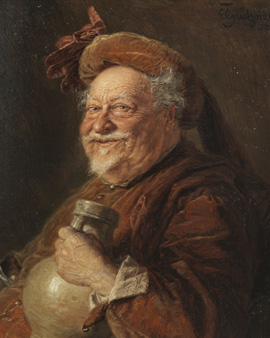Der Maler Eduard Theodor Grützner und später dann Ritter von Grützner ist einer der bedeutendsten Münchener Genremaler der zweiten Hälfte des 19. Jahrhunderts. In der Geschichte gilt er als „Mönchmaler“, da er in seinen Bildern das Klosterleben in den Mittelpunkt stellte. Bei den Kunstwerken von Eduard Theodor Grützner fiel häufig auf, dass er das Klosterleben immer sehr heiter und ausgelassen darstellte und die asketischen Kardinäle oftmals mit unsympathischen Gesichtszügen festhielt. Trotz dessen dass nur wenige Gemälde des Stilllebens von Eduard Theodor Grützner existieren, liebte er diese Art von Kunstwerken ganz besonders und malte diese leidenschaftlich gerne.
Das Talent des Malers Eduard Theodor Grützner wurde schon im frühen Kindesalter erkannt und sowohl von der Kirche als auch vom Adel gefördert. Als jüngstes Kind einer armen Bauernfamilie malte er auf allem was er in die Hände bekam und machte somit vielen Dorfbewohnern mit seinen Tier- und Menschen Zeichnungen bereits in jungen Jahren eine Freude. Durch den Dorfpfarrer und den Architekten Hirschberg bekam Eduard Theodor Grützner die Möglichkeit höhere Schulen zu besuchen und zum Künstler ausgebildet zu werden. Er lernte verschiedene Künstler wie Hermann Dyck, Hermann Anschütz und Carl Theodor von Piloty kennen und wurde von ihnen sowohl in Malerei als auch zu Themen wie die Schönheitsideale des Altertums unterrichtet. Dies war aber nur von kurzer Dauer, denn schon bald bezog Eduard Theodor Grützner sein eigenes Atelier in München und erschuf seine eigenen Bilder. Eduard Theodor Grützner war nicht nur begeisterter Maler sondern auch leidenschaftlicher Sammler. Er begann schon in seiner Jugend Mineralien und Schmetterlinge zu sammeln. Auf Grund seiner Begeisterung für das Sammeln zeichnete er bereits mit 14 Jahren eine Kopie des „Lehrbuch der Krystallkunde“ des Mineralogen Carl Rammelsberg. Eduard Theodor Grützner sammelte besondere Stücke aus der Zeit der frühen Renaissance und deutschen Spätgotik. Dies spiegelte sich auch in seiner Malerei wider. Auf Grund seiner großen Leidenschaft zum Sammeln malte er Portraits von Mineralogen und Geologen, die er für deren Arbeit bewunderte. Im höheren Alter sammelte Eduard Theodor Grützner bevorzugt Kunstwerke aus dem Fernen Osten und lernte die japanische Sprache. Er beschäftigte sich viel mit der chinesischen Philosophie und ließ das auch in seine Malerei einfließen. Er arbeitete Buddhafiguren oder chinesische Vasen in seine Kunstwerke ein. Dabei hob er besonders in seinen größeren Kompositionen seine Sammlerstücke aus dem Fernen Osten, aus seiner eigenen Antiquitätensammlung hervor.
Der Maler Eduard Theodor Grützner genoss ein großes Ansehen unter seinen Malerkollegen und vom Adel. So wurde von dem Maler und Schriftsteller Friedrich Pecht in einer Zeitschrift verkündet, dass Eduard Theodor Grützner den Professorentitel von dem Prinzregent persönlich verliehen wurde. Weiterhin erhielt Eduard Theodor Grützner das Ritterkreuz vom Heiligen Michael und wurde im Jahr 1916 aufgrund der Verleihung des Verdienstordens der Bayerischen Krone in den persönlichen Adelsstand erhoben.
×





.jpg)
.jpg)
.jpg)
.jpg)
.jpg)
.jpg)
.jpg)
.jpg)
.jpg)
.jpg)
.jpg)
.jpg)
.jpg)
.jpg)
.jpg)
.jpg)
.jpg)
.jpg)
_prueft_-_(MeisterDrucke-823319).jpg)
_prueft_-_(MeisterDrucke-823319).jpg)
.jpg)
.jpg)
.jpg)
.jpg)
.jpg)
.jpg)
.jpg)
.jpg)
.jpg)
.jpg)
.jpg)
.jpg)
.jpg)
.jpg)
.jpg)
.jpg)
.jpg)
.jpg)
.jpg)
.jpg)
.jpg)
.jpg)
.jpg)
.jpg)
.jpg)
.jpg)
.jpg)
.jpg)
.jpg)
.jpg)
_(preteur_sur_gage)-_Peinture_de_Eduard_von_Gruetzn_-_(MeisterDrucke-1325333).jpg)
_(preteur_sur_gage)-_Peinture_de_Eduard_von_Gruetzn_-_(MeisterDrucke-1325333).jpg)
.jpg)
.jpg)
.jpg)
.jpg)
.jpg)
.jpg)
_-_(MeisterDrucke-118826).jpg)
_-_(MeisterDrucke-118826).jpg)
.jpg)
.jpg)






